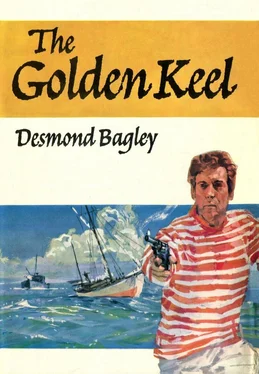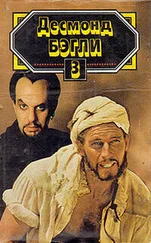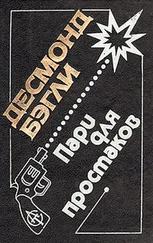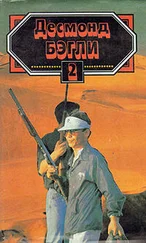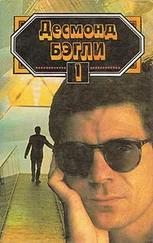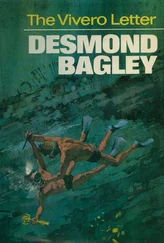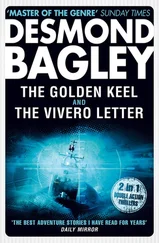Coertze had warned us about it. He had said that it would be full of flaws and cracks and that it would be structurally weak. Sanford had taken a hell of a hammering in the last couple of days and this last squall was the straw that broke the camel’s back — or broke the ship’s keel.
I looked over the side again, trying to estimate how much higher she was in the water. As near as I could judge three parts of the keel were gone. Sanford had lost three tons of ballast and she was in danger of capsizing at any moment.
I hammered on the cabin hatch and yelled at the top of my voice. Coertze popped his head out. ‘What’s wrong?’ he shouted.
‘Get on deck fast — Francesca, too. The bloody keel’s gone. We’re going to capsize.’
He looked at me blankly. ‘What the hell do you mean?’ His face flushed red as the meaning sank in. ‘You mean the gold’s gone?’ he said incredulously.
‘For Christ’s sake, don’t just stand there gaping,’ I shouted. ‘Get the hell up here — and get Francesca out of there. I don’t know if I can hold her much longer.’
He whitened and his head vanished. Francesca came scrambling out of the cabin with Coertze on her heels. Sanford was behaving like a crazy thing and I shouted to Coertze, ‘Get that bloody sail down quick or she’ll be over.’
He lunged forward along the deck and wasted no time in unfastening the fall of the halyard from the cleat — instead he pulled the knife from his belt and cut it with one clean slice. As soon as the sail came down Sanford began to behave a little better, but not much. She slithered about on the surface of the water and it was by luck, not judgement, that I managed to keep her upright, because I had never had that experience before — few people have.
Coertze came back and I yelled, ‘It’s the mast that’ll have us over if we’re not careful.’
He looked up at the mast towering overhead and gave a quick nod. I wondered if he remembered what he had said the first time I questioned him about yachts in Cape Town. He had looked up at the mast of Estralita and said, ‘She’ll need to be deep to counterbalance that lot.’
The keel, our counterbalance, had gone and the fifty-five foot mast was the key to Sanford ’s survival.
I pointed to the hatchet clipped to the side of the cockpit. ‘Cut the shrouds,’ I shouted.
He seized the hatchet and went forward again and swung at the after starboard shroud. It bounced off the stainless steel wire and I cursed myself for having built Sanford so stoutly. He swung again and again and finally the wire parted.
He went on to the forward shroud and I said, ‘Francesca, I’ll have to help him or it may be too late. Can you take the helm?’
‘What must I do?’
‘I think I’ve got the hang of it,’ I said. ‘She’s very tender and you mustn’t move the tiller violently. She swings very easily so you must be very gentle in your movements — otherwise it’s the same as before.’
I couldn’t stay with her long before I had to leave the cockpit and release both the backstay runners so that the stays hung loose. The mast now had no support from aft.
I went forward to the bows, clinging on for dear life, and crouched in the bow pulpit, using the marline-spike of my knife on the rigging screw of the forestay. The spike was not designed for the job and kept slipping out of the holes of the body, but I managed to loosen the screws appreciably in spite of being drenched every time Sanford dipped her bows. When I looked up I saw a definite curve in the stay to leeward which meant that it was slack.
I looked round and saw Coertze attacking the port shrouds before I bent to loosen the fore topmast stay. When I looked up again the mast was whipping like a fishing rod — but still the damn’ thing wouldn’t break.
It was only when I tripped over the fore hatch that I remembered Walker. I hammered on the hatch and shouted, ‘Walker, come out; we’re sinking.’ But I heard nothing from below.
Damning his minuscule soul to hell, I went aft and clattered down the companionway and into the main cabin. I staggered forward, unable to keep my balance in Sanford ’s new and uneasy motion and tried the door to the fo’c’sle. It was locked from the inside. I hammered on it with my fist, and shouted, ‘Walker, come out; we’re going to capsize.’
I heard a faint sound and shouted again. Then he called, ‘I’m not coming out.’
‘Don’t be a damned fool,’ I yelled. ‘We’re liable to sink at any minute.’
‘It’s a trick to get me out. I know Coertze’s waiting for me.’
‘You bloody idiot,’ I screamed and hammered on the door again, but it was no use; he refused to answer so I left him there.
As I turned to go, Sanford groaned in every timber and I made a dash for the companionway, getting into the cockpit just in time to see the mast go. It cracked and split ten feet above the deck and toppled into the raging sea, still tethered by the back and fore stays.
I took the tiller from Francesca and tentatively moved it. Sanford ’s motion was not much better — she still slid about unpredictably — but I felt easier with the top hamper gone. I kicked at a cockpit locker and shouted to Francesca, ‘Life jackets — get them out.’
The solving of one problem led directly to another — the mast in the water was still held fore and aft and it banged rhythmically into Sanford ’s side. Much of that treatment and she would be stove in and we would go down like a stone. Coertze was in the bows and I could see the glint of the hatchet as he raised it for another blow at the forestay. He was very much alive to the danger inherent in the mast.
I struggled into a life jacket while Francesca took the helm, then I grabbed the boathook from the coach roof and leaned over the side to prod the mast away when it swung in again for another battering charge. Coertze came aft and started to cut away the backstays; it was easier to cut them on the deck and within five minutes he had done it, and the mast drifted away and was lost to sight amid the sea spray.
Coertze dropped heavily into the cockpit, his face streaming with salt water, and Francesca gave him a life jacket. We fastened our safety lines and, on a sudden impulse, I battened down the main hatch — if Walker wanted to come out he could still use the fore hatch. I wanted to seal Sanford — if she capsized and filled with water she would sink within seconds.
Those last moments of the squall were pretty grim. If we could last them out we might stand a chance. Sanford would never sail again, but it might be possible to move her slowly by a judicious use of her engine. For the first time I hoped I had not misled Metcalfe and that he would be standing by.
But the squall had not done with us. A violent gust of wind coincided with a freak sea and Sanford tilted alarmingly. Desperately I worked the tiller, but it was too late and she heeled more and more until the deck was at an angle of forty-five degrees.
I yelled, ‘Hang on, she’s going,’ and in that moment Sanford lurched right over and I was thrown into the sea.
I spluttered and swallowed salt water before the buoyancy of the jacket brought me to the surface, lying on my back. Frantically I looked round for Francesca and was relieved when her head bobbed up close by. I grabbed her safety line and pulled until we floated side by side. ‘Back to the boat,’ I spluttered.
We hauled on the safety lines and drew ourselves back to Sanford. She was lying on her starboard side, heaving sluggishly over the waves, and we painfully crawled up the vertical deck until we could grasp the stanchions of the port safety rail. I looked back over the rail and on to the new and oddly shaped upper deck — the port side of Sanford.
Читать дальше
Конец ознакомительного отрывка
Купить книгу
